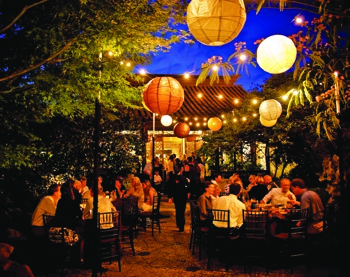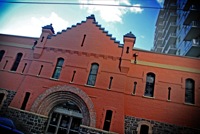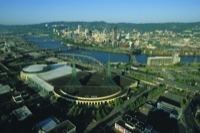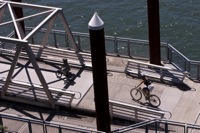
In Portland, Ore., green has been more than a color for a long time. As other cities have scrambled to board the sustainability train, Portland had left the station, already miles ahead of its peers. It is, after all, American’s Greenest City, according to Popular Mechanics, where 63 percent of citizens recycle, 5,000 ride bikes to work and 300,000 commute by buses, light rail and streetcars.
In terms of green, Portland LEEDs
For groups that aim to meet gently on the earth, Portland is heaven. Its convention center is LEED (Leadership in Energy and Environmental Design) certified. So are a number of its hotels and off-site meeting spaces. Its restaurants delight in turning old barns into tables and old tables into cutting boards.
Portland also sustains itself in the food and beverage department, heaping its dining tables with locally grown produce and freshly caught fish, brewing its own beverages at 38 craft breweries and 62 area wineries.
“People who come here expect that because that’s who we are, and we promote the heck out of it,” said Lindsey McBride, a public relations professional.
“It is a part of our daily life,” said local Barb Lee, who oversees events at BridgePort Brewing Co.
Even meetings and conventions that aren’t in tune with the environment find much to like and to learn in what is not only one of America’s most progressive cities, but also one of its most interesting and inviting.
Using ingenuity to save energy
Portland’s biggest green endeavor, at least in terms of square footage, is the Oregon Convention Center, across the Willamette River from the central business district.
 |
|
| By Josh Oakhurst |
The first convention center in the United States to achieve LEED recertification at a higher level than it originally achieved, the 19-year-old facility nearly doubled in size in 2003.
A five-acre roof shelters almost 1 million square feet of space and collects rainfall, routing it into a boulder- and plant-filled rain garden that edges the convention center’s river side. The rain garden filters the water and returns it to the river.
The center also recycles more than 250 tons of materials each year, and easy-to-use recycling bins allow attendees and exhibitors to do their part.
Not to be content, the center continues to look at ways to be greener. It has accelerated its composting program; induction lighting to be installed in exhibit halls will cut energy use in those space by 50 percent.
Already, about half of the center’s energy needs are supplied by wind energy; it will grab another 10 to 12 percent from the sun when a solar energy system is installed on its roof this year.
“We are moving toward 100 percent renewable energy,” said Brittin Witzenburg, sustainability coordinator.
“If you come to the Oregon Convention Center, you are having a green meeting whether you like it or not,” adds Matt Pizzuti, director of sales and marketing.
Most will like it, particularly when they realize that the center’s green efforts allow it to keep operational costs in line. “Last year, we didn’t raise any of our fees,” said Pizzuti.
The center also sustains in other ways. Like other construction projects in Portland, the it was required to spend 1 percent of the cost of its expansion to buy public art. The money was well spent on whimsical pieces like a dragon boat that hangs in one atrium and a glass sculpture inspired by the gingko, a primordial tree of Oregon, in the concourse. The center also promotes fun, with a new bar called Stir, where the signature drink is the Solartini.
The convention center’s stumbling block is the lack of an upscale attached hotel, which has long been discussed but is going nowhere because of the economy. Two hotels, the Inn at the Convention Center and a Red Lion Hotel in Portland Convention Center are nearby.
Lack of sales tax means savings
The separation from downtown created by the river is easily overcome thanks to a light rail system that stops at the convention center and whisks riders to downtown in 10 to 15 minutes.
And, as Travel Portland, the city’s convention bureau, points out, the divide is easy to overlook when meeting planners consider the savings of 16 to 22 percent that they realize since there is no sales tax and no tax on food and beverage in the city.
Old Armory becomes trend-setter
Another leader in green design is the Gerding Theater at the Armory, primarily the home of Portland Center Stage, and a popular meeting and event venue since it opened four years ago.
The building is Portland’s old Armory, a fortress of brick and stone built in 1891. Like other buildings that are now part of the Pearl entertainment district, the Armory had fallen on hard times. It was slated to be torn down but locals were determined to save it.
“Our citizens hate to throw anything away,” said Deborah Wakefield, former vice president of communications for Travel Portland. “There was an uprising.”
Thus began a restoration that made the old armory the first building on the National Register of Historic Places to receive LEED Platinum status.
To give a building with 20,000 square feet of space more than twice that, crews dug 30 feet below the floor of the old building. Today the building houses a 500-seat main stage theater and a 200-seat black box theater as well as a three-story lobby and mezzanine where allow reception-goers can admire original roof supports made from Douglas fir, the state tree.
Architects and developers from other cities are frequent visitors, examining green elements like a system that collects rainwater from the roof to water landscaping and flush toilets.
A neighborhood space and meeting place
In addition to 450 performances each year, there are about 750 events at the old Amory, making good on city leaders’ promise that the facility would be a neighborhood space.
 |
| Courtesy Oregon Convention Center |
“Yes, we wanted a wonderful theater space but there was a strong sense of wanting it to be a community space as well,” said Cynthia Fuhrman, marketing and communications director.
Reusing old buildings like the Armory is another way Portland promotes sustainability. The hotel sector has been particularly atune to giving old buildings new lives. Portland’s four newest hotels are rehabs of old buildings.
The most notable is The Nines, the former 1909 Meier and Frank department store, now a 331-room hotel with enough original artwork — 419 pieces hand-picked by Paige Powell, a protégé of Andy Warhol’s — to stock a good-size museum. The Nines is part of the Starwood Collection and served as headquarters hotel for SC09, an international computing conference that returned to the Portland Convention Center last fall after first meeting there in 1993 and 1999.
The Nines has earned LEED Silver certification. Its water-conserving plumbing fixtures save 400,000 gallons of water a year; 90 percent of the 24 million pounds of debris created by the renovation was diverted from landfills.
From its hyperactive lobby, which operates like a giant great room with a bar, a restaurant and cliquey conversation areas to its rooftop bar, the Nines is no sleepy city hotel. It occupies the top 10 floors of the building; below it, a Macy’s department store occupies the building’s first five floors.
This library is not just for reading
Among its surprises is the Library, a casual room off the lobby outfitted with 3,000 books from Powell’s, the noted Portland bookstore; photos taken by director, musician and author Gus Van Sant; and a billiard table. An “unexpected find,” is how Laura van Daal, director of sales and marketing, describes it.
An entire floor just below the lobby, is dedicated to meetings, 13,500 square feet in all that includes a 7,100-square-foot ballroom and several sunny board rooms. A special event space replicates Meier and Frank’s tearoom, a favorite of longtime Portland residents.
Around the corner and down the street, an old Day’s Inn motor lodge is now a mod, mid-century hotel, home to Nel Centro, a restaurant where owner-chef David Machado preaches and practices sustainability, from tables “made from a barn in Bend,” according to publicist McBride to meals fragrant with fresh herbs that accentuate the menu’s Mediterranean influences.
Like The Nines, Hotel Modera is packed with local art, about 500 pieces, and the 168-room hotel has about 2,500 square feet of meeting space, including a private dining area.
One of the most interesting features of the hotel, a member of Small Luxury Hotels of the World, is a courtyard where a 60-space parking lot once sat. Pavement has been replaced by outdoor seating around firepits, landscaping and even a living wall that filters rainwater.
“This went from being an eyesore to an asset,” said McBride.
The Orient, expressed
Portland is also green in the more traditional sense, with plenty of parks and green spaces. Among its most arresting landscapes are its Japanese and Chinese gardens, both of which do a lively meeting and event business.
 |
| Courtesy Travel Portland |
Shaded by Douglas firs, the Portland Japanese Garden is a sloped and terraced 5 and a half acres above the city in Washington Park; it was once home to the Portland Zoo; a waterfall now spills over the old bear den.
After 10 years of dreaming and planning, the garden opened in 1967, designed by Japanese professor Takuma Tono.
Not one, but two Japanese ambassadors have proclaimed it the most authentic Japanese garden — one specifying gardens outside Japan; the other including gardens in his homeland.
Five gardens set different moods, from a Strolling Garden with an arching bridge to a flat garden of raked sand and stone, The goal was to create “a Northwest garden with Japanese flair,” said Kerry Cobb, director of marketing and communications.
Dinners for 100 can be held in the garden’s low-slung Japanese pavilion, with an adjacent deck that boasts one of the city’s best views of snow-topped Mount Hood.
A parking lot becomes paradise
When you step inside Lan Su Chinese Garden, it is hard to believe just 10 years ago, this urban oasis, a block from the light rail line in Portland’s Chinatown, was a parking lot.
It took 65 Chinese artisans from Portland’s Sister City, Suzhou, a year to build the pond, pavilions, pathways and the garden’s centerpiece, an authentic tea house. Because plants could not be imported from China, the garden designer sourced plants and trees from area neighborhoods. Citizens willingly donated their landscaping for the project.
“A lot of people come here and have a personal connection because one of their plants lives here,” said Wakefield.
Only four minutes from the Oregon Convention Center by light rail, the garden sees its share of conventioneers.
“Literally every conference that comes to town, we get people who sneak over here,” said Scott Steele, communications manager, whose seen more than one visitor dragging their rolling luggage through the garden, making a stop enroute to the airport.
The walls of the garden and the tinkle of water muffle the city sounds; it’s easy to image sipping a glass of wine (white only as red is not allowed) as the sun sets or as a full moon reflects in the lily pond.
There are many ways groups can use the garden — a traditional reception, organized garden tours; group tai chi sessions or a tea ceremony in the teahouse.
In addition to being a place of solitude, the garden is a place of peace, where prickly meetings are smoothed by the soothing sounds and scents that are such a surprise in the middle of the city.
“That is the reason Chinsese gardens were built, is to bring nature to urbanites,” said Jane DeMarco, manager director. “You can come in here and feel less agitated. People come in and you see the tension just flow.”
On the whole, it is hard to be too tense in a city of a half a million that manages to feel much smaller. Perhaps it is because Portland is so manageable.Public transit takes the headache out of getting around, a walkable downtown and riverfront makes it easy to stretch the legs and a selection of 4,500 restaurants makes it a pleasure to dine out.
For meetings and special events, DeMarco believes the Lan Su Chinese Gardens “improves your RSVP quota.” Those who’ve met in Portland, probably say the same about Oregon’s largest city.











